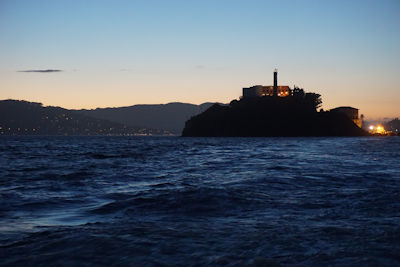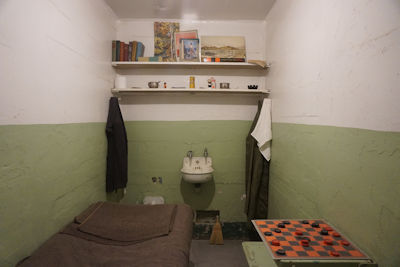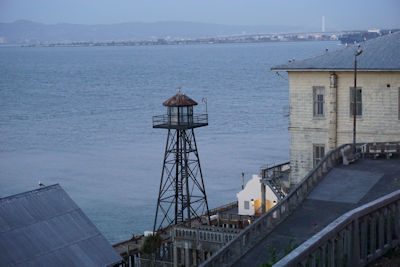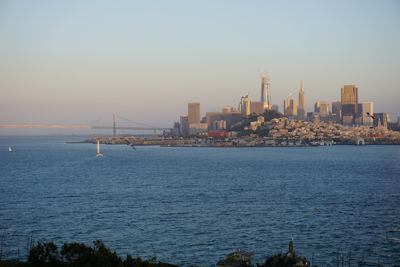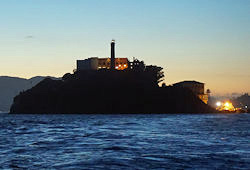
On March 21, 1963, the federal penitentiary on Alcatraz officially closed. After nearly thirty years as the internment home for some of the most infamous gangsters, murderers, and thieves of the twentieth century, the small island off the coast of San Francisco ended its brief notoriety as an escape proof facility on an uneventful day that came-and-went with little fanfare.
The Rock in the middle of a Bay was formally named Alcatraz by a Spanish naval lieutenant in 1775 because of its multitude of pelican inhabitants, then went virtually forgotten for 75 years before the US Military realized its strategic value. During the Civil War, confederate prisoners were sent to Alcatraz and the potential for the island as an “escape-proof prison for hard-core offenders” began to crystalize as well.
The military abandoned Alcatraz in 1934, the same year that FBI Director J. Edgar Hoover was in the midst of his “war with the American gangster” and determined to establish a “super-prison” within the United States to detain the country’s most dangerous convicts. Once the military had vacated the island, it didn’t take long before Alcatraz became that prison.
In his 2013 book Alcatraz: A Definitive History of the Penitentiary Years, Michael Esslinger offers a biographical account of the island prison, as well as the various notorious criminals who found themselves held captive on the Rock. Al Capone is by far the most famous of the group, and his story as the predominant gangster kingpin of the Prohibition Era has been well documented in both film and literature.
After being convicted of tax evasion in 1931, Capone was initially interned at Atlanta Federal Penitentiary where he found it relatively easy to manipulate his surroundings, bribe security guards, and continue to live in relative comfort despite his incarceration. It was because of this ability to “leverage the system” that Al Capone was moved to Alcatraz in 1934, suddenly becoming just another prisoner in a much harsher environment with limited access to the outside world.
George “Machine Gun” Kelly was another legendary criminal of the 1920s and 30s who ended up on Alcatraz. Originally a bootlegger, he moved on to bank robbery and kidnapping after marrying Kathryn Thorne in 1930. Thorne herself had a criminal background as well as a flair for the dramatic. It was Thorne, for instance, who purchased a machine gun for her husband and spread word of his notoriety throughout the underworld.
This new-found fame, however, also led to Kelly’s eventual rise to “Public Enemy Number One” and later conviction in the kidnapping of oil tycoon Charles Urscehl. Initially sent to Leavenworth, Kelly bragged that he could escape from the prison with relative ease at any time that he chose. His boasts were taken seriously, and George Kelly was soon transferred to Alcatraz as a precaution.
While Al Capone remained defiant while on the Rock, the same was not true of Machine Gun Kelly. According to Michael Esslinger, Kelly “took a job as an altar boy in the prison chapel, worked in the laundry and served out his time quietly.”
Alcatraz had a total of five wardens during its tenure as a Federal Penitentiary – James A. Johnston (1934-1948), Edwin B. Swope (1948-1955), Paul Madigan (1955-1961), and Olin Blackwell (1961-1963) – and Michael Esslinger includes brief biographical sketches of each of them in Alcatraz: A Definitive History as well. As a whole, the wardens were “strict disciplinarians” who likewise showcased a “humanistic approach to reform,” albeit in their own unique ways.
Each successive warden also brought new levels of deregulation regarding the treatment of prisoners under their care, from the screening of two movies a month as entertainment, the elimination of a “bread and water diet” for those in solitary confinement, and additional items added to the yearly Christmas gift packages. Those locked away on Alcatraz continued to follow strict, structured routines no matter who was in charge, however, while insubordination was likewise never tolerated.
In 1969 – six years after the prison had been abandoned – Alcatraz became a symbol of protest against the federal government when a group of Native American activists took control of the island. The resulting occupation lasted two years, ending shortly after President Richard Nixon officially established a policy of self-determination for the indigenous tribes of North America in 1971.
The allure of Alcatraz goes beyond the historical, however, and into the realms of popular culture as well. The island has been the subject of many major motion pictures though the years, ranging from the reality-based The Birdman of Alcatraz and Escape from Alcatraz – starring Burt Lancaster and Clint Eastwood, respectively – to the fictional action thriller The Rock that featured Sean Connery and Nicolas Cage.
Although not as well known, Alcatraz has also appeared in a number of comic books, with the likes of Captain America, the Hulk, and the X-Men all visiting the former penitentiary. In a three-part Incredible Hulk/Captain America crossover from Marvel Comics in 1979, for instance, Steve Rogers arrives on the island as a tourist in search of his kidnapped partner the Falcon, only to find a steel door leading to the clandestine lair of the evil Corporation hidden beneath the legendary prison. A drugged Bruce Banner was also being held captive, leaving the alter egos of both men to devise their own escape from Alcatraz.
Two decades later, the same feat was accomplished by the X-Men when their mentor Professor Xavier was taken prisoner by the Brotherhood of Mutants and likewise locked away beneath the prison cells of Alcatraz.
Ten years after closing as a federal penitentiary, Alcatraz was transformed into a national park and tourist attraction, topping the “must see” list for many travelers to the San Francisco area. Visitors are now able to walk within the confines of the same jail as Al Capone, peak inside cells that once contained the likes of Machine Gun Kelly, and gaze at the San Francisco skyline across the bay.
An estimated 1.7 million people visit Alcatraz each year. What they find is an island that is both hauntingly desolate and beautifully picturesque – a rock in the middle of a bay that offers mesmerizing views, a feeling of dread, and a long history wrapped in fact as well as fiction.
Anthony Letizia
